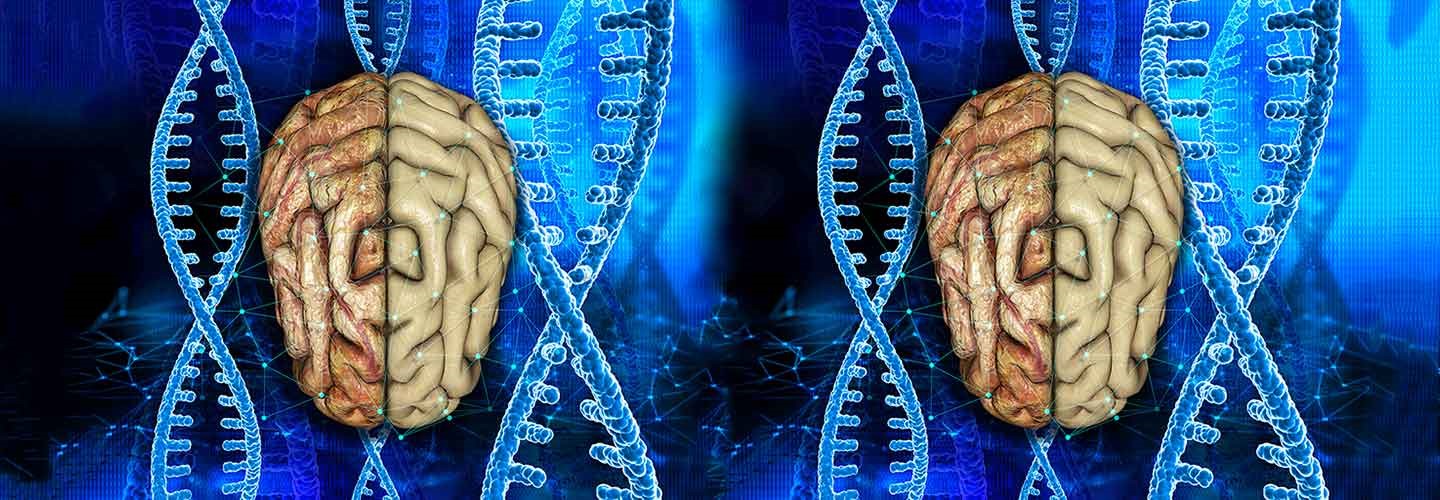“Will I Lose my Mind Someday?” How APOE, ABCA7 and LRP1 Genes Can Predict the Risk of Alzheimer’s Disease—And What You can Do About It – Part 1
- Home
- Blog

Reader, what is the biggest fear or concern you have when it comes to growing older? Many of us may be quick to answer that it’s a deep fear of physical decline. Others may be concerned with whether they’ve saved enough to be able to afford good quality of life right up until the very end. From losing close friends and family members to worrying over the possibility of chronic pain, the trepidation over the known unknowns—and unknown unknowns—of ageing can be stressful. But the most pervasive concern I hear at my office is simply this: What if I lose my mind? I hear sentiments like this often from those who have had to watch their own parents slowly become unrecognizable to them through the slow, painful progression of vascular dementia and Alzheimer’s disease, who deeply fear going through the same dreaded process. I also hear these concerns from people who, in middle age, may already be suffering from memory problems, who fear these may be a precursor for something much worse and all-consuming.
For a long while, researchers believed that Alzheimer’s disease was not preventable—that once diagnosed it could only be treated with palliative care. But reader: the science has shifted. We now know that the processes behind Alzheimer’s disease begin 20-30 years before diagnosis—this is huge! And at the forefront of this new research is—you guessed it—the field of genetics. Scientists now understand that certain genes may predispose us to significantly higher rates of developing Alzheimer’s. Armed with that information, we can now begin to take control of our cognitive future today.
For the next four weeks, I’ll be walking you through four different sets of genes at the forefront of Alzheimer’s research. I’m going to tell you how these genes function, how you may be affected, and most importantly, what you can do about it. In Part 1, I will discuss LRP1, APOE, and ABCA7, genes responsible for clearing neuronal debris (“waste”) from your brain. In Part 2, we will dive into TREM2 and CD33, genes responsible for neuronal inflammation. In Part 3, we will return to two genes you will be very familiar with if you’ve been following my blog—COMT and BDNF—as they relate to Alzheimer’s. In Part 4, I will introduce you to LRRK2, the “Parkinson’s Gene”. Now, without further ado, let’s dig into Part 1!
A Quick Review: What is Alzheimer’s?
There are many diseases and conditions that could cause or be associated with the symptoms of dementia but Alzheimer’s disease is the leading cause. Alzheimer’s accounts for approximately 70% of all cases of dementia in the United States. According to the Alzheimer’s Association nearly 5.4 million Americans are currently living with the disease and the biggest risk factor is advanced age (60 or older). Initial symptoms of Alzheimer’s are often mistaken for normal ageing—however, a distinctive hallmark of neurodegeneration in AD are amyloid plaques. Amyloid β is the main component of amyloid plaques (extracellular deposits found in the brains of patients with Alzheimer’s disease). The plaques are composed of a tangle of regularly ordered fibrillary aggregates called amyloid fibers. The “amyloid hypothesis”, which posits that plaques are responsible for the pathology of Alzheimer’s disease, is accepted by the majority of researchers. Malfunction of the microglia can also lead to Alzheimer’s. Microglia are the immune cells of the brain, and they have one key role: clearing cellular debris, including amyloid.
Now, amyloid plaques and microglia are only part of the picture. Epigenetic factors can also leave an individual more prone to Alzheimer’s, as well as other genetic concerns, which we will cover in later series. I encourage you to read a more in-depth analysis of the cutting edge research on my prior blogs, which can be found here and here. We will cover a lot of ground in this series—and today, we’re going to start with amyloid plaque buildups and neuronal debris, and how your genes play a role in both.
APOE, ABCA7, and LRP1—Your Brain’s “Waste Product Clearance Systems”
Reader, think back for a moment to the last time you went to the dentist. Perhaps you hadn’t visited for a long time. It’s safe to say, if that were the case, you’d have plenty of plaque built up between your teeth. Now, think like a dentist for a moment: What causes that thick, persistent substance to build up over time? A lack of brushing and flossing does the trick. Those tools are your very own clearance system—if you’re using them well, plaque and debris is flushed out of your mouth and into the sink.
Your brain is not so different—except your clearance system is not a toothbrush and a pack of floss, but your genes… specifically your APOE, ABCA7, and LRP1 genes. Each of these genes plays a role in clearing out the “waste products” in your brain, including those pesky amyloid plaques, tau proteins and other debris such as dead cell fragments and excessive amounts of cholesterol (some cholesterol is essential for repairing neurons). More specifically, they regulate the transport of these molecules out of the brain and if that transportation is irregular, amyloid plaques and tau tangles begin to build up and eventually damage and destroy normal cellular functions. This process happens very slowly over time—decades —but with the right genetic information about your personal genome, you may be able to do something about that buildup now. It’s never too late to start brushing your teeth, after all—and it’s never too late to adjust your genes through lifestyle changes before the cellular damage becomes irreversible!
APOE
APOE, or apolipoprotein, is a multifunctional protein that plays a central role in lipid metabolism, and thus in clearance of cellular debris. Depending on which variant your APOE gene has, your body may be impressively effective at metabolizing and clearing out debris… or it may be quite weak at the same task. With an APOE2 variant, you’re equipped with a brand-new toothbrush and you have floss in every pocket and purse and desk drawer—and you use it. But with an APOE4 variant, you don’t have a toothbrush at all—you’re just swishing water and praying for good luck and no cavities. Unfortunately, if you possess two alleles of the latter sort of “risk” gene, you may have a fifteen times greater risk of being diagnosed with Alzheimer’s than your “resilient” genetic counterpart. Your body is simply less able to clear those damaging amyloid and tau molecules and other cellular debris.
ABCA7
Like APOE, ABCA7 plays a vital role in the clearance of Amyloid β proteins and dead cell debris. Without proper clearance, a buildup of abnormal protein tangles can occur, leading to cellular and mitochondria damage and death. If you have a G allele variant on your ABCA7 gene, you have a nearly 20% greater likelihood of developing Alzheimer’s.
LRP1
As with the genes above, a risk variant on your LRP1 gene promotes clearance dysfunction as well as lipid metabolism problems in the brain. As a modulator of sorts for cholesterol and lipid production—again, two key ingredients that help your body flush out amyloid plaques and other debris, LRP1 risk genes can lead to decreased lipid activity in the brain and therefore increased buildup.
So I Have an Alzheimer’s Risk Gene… Now what?
If your genetic test results show risk variants on one or more of these genes, you may be unsure of your next move. What do you do if your body isn’t naturally equipped with a high-functioning “toothbrush and floss” clearance system? Fortunately, just as science has pointed to more specific causes of Alzheimer’s, it’s also shed light on specific solutions to help fill in the weak points in your genetic code. Eating a Mediterranean diet has been shown to reduce the risk of Alzheimer’s by ten percent—and possibly up to 30 percent with strict adherence. Similarly, a meta-analysis of studies showed significant correlation between Vitamin D deficiency and cognitive impairment. Insufficient Vitamin D confers a twofold increase of odds in developing dementia—increasing your body’s Vitamin D levels could go far in helping you stave off Alzheimer’s cruel grip. Sleep is very important in the fight against Alzheimer’s, and studies of melatonin as a supplement show a clear benefit to sleep and cognition. Other interventions might include carotenoids, melatonin, phosphatidyl serine and PEA.
The bottom line: Your genes may predispose you to losing your mind, but once you understand your personal genome, lifestyle changes can help you preserve and protect it.
Related Information
- Learn about Genetic Testing
- Learn about Potomac Psychiatry
- Meet Our Doctors
- Contact Potomac Psychiatry


